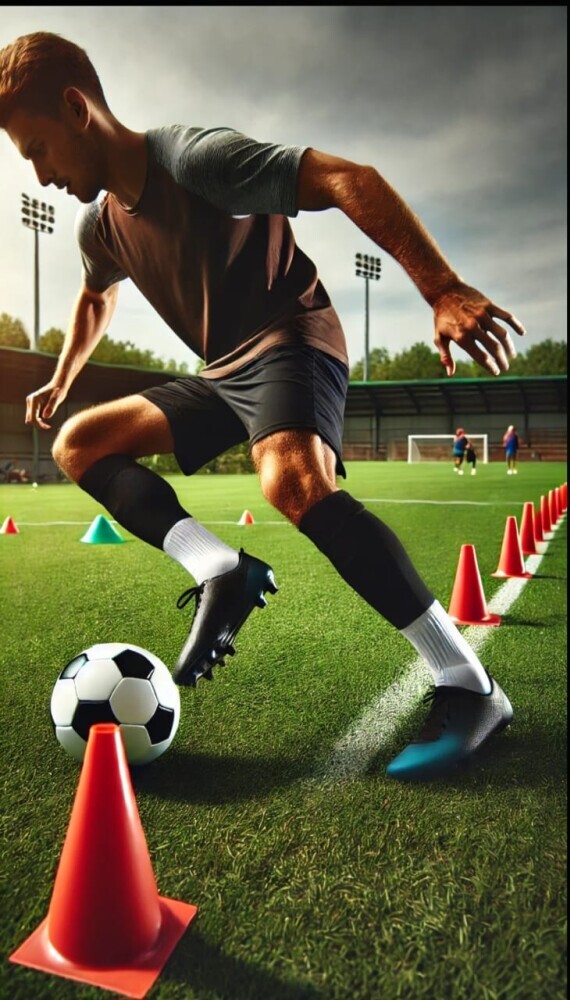Introduction to the Close Control Dribbling Drill
The Close Control Dribbling Drill is designed to improve a player’s ability to maintain tight control of the ball in confined spaces.
This drill focuses on enhancing precision, agility, and ball handling skills, which are crucial for maneuvering through defenders and maintaining possession in tight areas.
It is an essential exercise for players of all levels who want to refine their dribbling capabilities.
Setting Up the Drill:
a) Equipment Needed:
- Soccer ball
- Cones (minimum of 10-15)
- A flat, open space (such as a soccer field or training ground)
b)Setup Instructions:
- Create a small grid using cones, approximately 5 meters by 5 meters (16 feet by 16 feet). Adjust the size of the grid based on the player’s skill level—smaller for more challenge and larger for beginners.
- Ensure the cones are firmly placed to prevent them from moving during the drill.
Executing the Close Control Dribbling Drill:
a) Starting Position:
- Begin at one corner of the grid with the soccer ball at your feet.
- Stand with a balanced posture, knees slightly bent, and ready to move.
b)Dribbling Within the Grid:
- Using Both Feet: Dribble the ball within the confined space of the grid, using both the inside and outside of your feet. Focus on alternating touches to develop ambidextrous dribbling skills.
- Small Touches: Use small, controlled touches to keep the ball close to your feet. This helps in maintaining control while navigating through the grid.
- Change of Direction: Practice changing direction quickly and frequently. Use cuts, turns, and feints to maneuver around the grid, simulating real-game scenarios where you need to evade defenders.
- Maintain Control: Keep the ball close and under control at all times. Avoid letting the ball stray too far from your feet.
c)Incorporating Dribbling Moves:
- Inside and Outside Cuts: Use the inside and outside of your feet to cut sharply and change direction.
- Pull Backs: Use the sole of your foot to pull the ball back and change direction.
- Feints: Perform body feints to simulate changing direction and then quickly move the ball in the opposite direction.
- Quick Turns: Execute quick turns using the inside, outside, or sole of your foot to navigate the confined space effectively.
Advanced Variations:
a) Increase Speed:
- Gradually increase the speed at which you dribble within the grid while maintaining control. This adds an element of intensity and helps simulate game conditions.
b) Single-Foot Dribbling:
- Focus on dribbling within the grid using only your dominant foot. Repeat the drill using only your non-dominant foot to improve weaker foot skills.
c)Dynamic Cones:
- Have a partner move the cones slightly during the drill to create a dynamic environment that simulates real-game scenarios.
d)Combination Moves:
- Combine multiple dribbling moves in one sequence to make your dribbling more unpredictable and effective.
Common Mistakes to Avoid:
a) Over-Reliance on Dominant Foot:
- Avoid using only your dominant foot. Ensure you’re developing skills in both feet for balanced dribbling ability.
b)Looking Down at the Ball:
- Constantly looking down at the ball can hinder your awareness of the field. Practice keeping your head up to improve field vision.
c)Rushing the Drill:
- Don’t rush through the drill. Focus on maintaining control and precision rather than speed.
Benefits of the Close Control Dribbling Drill:
a) Improved Ball Handling:
- Regular practice enhances your ability to control the ball in tight spaces, crucial for navigating through defenders.
b)Enhanced Agility and Balance:
- The quick changes of direction and tight control improve your overall agility and balance, making you more adept at sudden movements during games.
c)Increased Confidence:
- Mastering this drill boosts your confidence in dribbling and handling the ball under pressure, translating to better performance on the field.
Incorporating the Drill into Your Training Routine:
a) Warm-Up: Use the close control dribbling drill as part of your warm-up to get your muscles engaged and ready for more intense training.
b) Consistent Practice: Integrate this drill into your regular training routine, aiming for at least 10-15 minutes per session.
c) Progress Tracking: Record your progress, noting improvements in control, agility, and precision. Challenge yourself to reduce the time taken to complete the drill while maintaining accuracy.
FAQs
a) What is the Close Control Dribbling Drill?
- Answer: The close control dribbling drill involves practicing dribbling techniques that emphasize keeping the ball close to your feet. The goal is to enhance precision and tight ball handling, which are crucial for maneuvering through tight spaces and avoiding defenders.
b)Why is the Close Control Dribbling Drill important?
- Answer: This drill is vital for developing a player’s ability to maintain possession under pressure, navigate through crowded areas on the field, and execute quick, precise movements. It improves overall ball control and dexterity.
c)How do I set up the Close Control Dribbling Drill?
- Answer: Set up a small grid using cones, approximately 5×5 meters. Dribble within the grid using small, controlled touches. Focus on changing direction frequently and using both feet to maintain control. You can increase the complexity by adding more cones or obstacles within the grid.
d)What are the key techniques to focus on during the Close Control Dribbling Drill?
- Answer: Focus on using the inside and outside of both feet, keeping your head up to survey the field, and maintaining a low center of gravity. Use short, quick touches to keep the ball close and change direction rapidly.
e) How can I vary the Close Control Dribbling Drill to make it more challenging?
- Answer: To increase difficulty, reduce the size of the grid, add more cones or obstacles, or incorporate defenders to apply pressure. You can also practice with one foot only or incorporate specific moves like the step-over or scissors.
f)What common mistakes should I avoid during the Close Control Dribbling Drill?
- Answer: Common mistakes include taking large touches that make it difficult to maintain control, not looking up to see the field, and losing balance. Focus on smooth, controlled movements and keeping the ball within close proximity.
g)How often should I practice the Close Control Dribbling Drill?
- Answer: For optimal results, incorporate the close control dribbling drill into your training routine 2-3 times a week. Consistent practice will help reinforce the skills and improve your overall performance.
h)Can the Close Control Dribbling Drill be adapted for team practice?
- Answer: Yes, this drill can be adapted for team practice by setting up multiple grids and having players compete against each other in small-sided games or relay races. This encourages a competitive spirit and adds variety to the training session.
i)What are the benefits of mastering the Close Control Dribbling Drill?
- Answer: Mastering this drill improves your ability to maintain possession in tight spaces, enhances your agility and balance, and boosts your confidence in dribbling under pressure. It also helps in developing better coordination and touch.
j)How can younger players benefit from the Close Control Dribbling Drill?
- Answer: Younger players can benefit by developing foundational dribbling skills early on. This drill helps them understand the importance of ball control and precision, which are essential for their growth as soccer players.
k)Are there any specific tips for advanced players practicing the Close Control Dribbling Drill?
Answer: Advanced players should focus on increasing the speed and intensity of the drill. They can incorporate complex moves and feints to simulate game scenarios. Practicing with added pressure from defenders can also help improve decision-making skills.
l) How does the Close Control Dribbling Drill improve a player’s overall game performance?
Answer: By enhancing ball control and precision, players can navigate through tight spaces more effectively, maintain possession under pressure, and create more opportunities to attack. This drill also helps in building muscle memory for better ball-handling skills during matches.
m) What variations of the Close Control Dribbling Drill can be used for different positions?
- Answer: For midfielders, emphasize quick turns and changes of direction to maintain possession. For forwards, focus on tight control to create scoring opportunities in crowded areas. Defenders can practice close control to improve their ability to dribble out of pressure situations.
n)How can I track my progress in the Close Control Dribbling Drill?
Answer: Track your progress by timing yourself during the drill and noting improvements in speed and control. Record the number of successful dribbles through the grid without losing possession. Regularly review using video analysis and adjust your training based on your performance.
0) Can the Close Control Dribbling Drill be combined with other drills for a comprehensive training session?
Answer: Yes, combine this drill with other dribbling, passing, and shooting drills for a well-rounded training session. For example, follow up with a shooting drill after dribbling through the grid to simulate game-like scenarios.
Conclusion
The Close Control Dribbling Drill is a versatile and effective exercise that enhances crucial skills such as ball control, coordination, and agility.
By consistently practicing this drill, you’ll develop superior control and confidence, essential attributes for any soccer player.
Whether you’re preparing for a match or simply looking to improve your overall game, this drill is an essential component of your training arsenal.
If you have any questions please leave them in the comment section below and I am happy to help you out.
Happy training.



Great article! The breakdown of the Close Control Dribbling Drill is incredibly helpful for players of all levels. I appreciate how you explained the setup and provided detailed steps on how to execute the drill with both feet and small touches. The tips on incorporating moves like pull-backs and quick turns are especially useful for building confidence in tight spaces. One question: For younger players just starting out, how would you suggest modifying the drill to ensure they don’t get discouraged by the difficulty? Thanks for sharing such valuable insights—I’ll definitely be incorporating this into my training routine!
Thank you for your kind comment.
I’m really glad you found the breakdown helpful, and I love that you’re planning to incorporate it into your training routine.
That’s exactly what it’s all about—giving players the tools they need to grow their confidence and skills!
Modifying the Drill for Younger Players
For younger or beginner players, the key is keeping it fun and manageable to avoid frustration. Here are a few ways to modify the Close Control Dribbling Drill to suit their skill level and help them build confidence gradually:
Slow Down the Pace
Start by removing any pressure to move quickly. Encourage them to focus on small, controlled touches at a pace they feel comfortable with. Once they get used to keeping the ball close, they can gradually speed up over time.
Reduce the Distance Between Cones
Spacing the cones closer together will make the movements easier, so they don’t have to worry about overextending their touches. You can start with 2-3 cones spaced a few feet apart and add more cones as they improve.
Use Only One Foot at a Time
To make it less overwhelming, let them focus on just one foot first (usually their dominant foot). Once they feel more confident, they can try switching feet or alternating touches.
Celebrate Small Wins
Building confidence is all about small victories. Praise every improvement—whether it’s smoother touches, a successful pull-back, or just completing the drill without stopping. This will keep them motivated and excited to keep practicing.
Add Fun Elements or Challenges
You could turn it into a game by timing their progress or setting little challenges like “How many cones can you get through in 30 seconds?” This helps shift the focus from perfection to fun and engagement.
I hope these modifications make the drill more accessible and enjoyable for younger players. The most important thing is for them to feel encouraged and keep practicing, and with time, they’ll naturally develop both skill and confidence.
Thanks again for your thoughtful comment